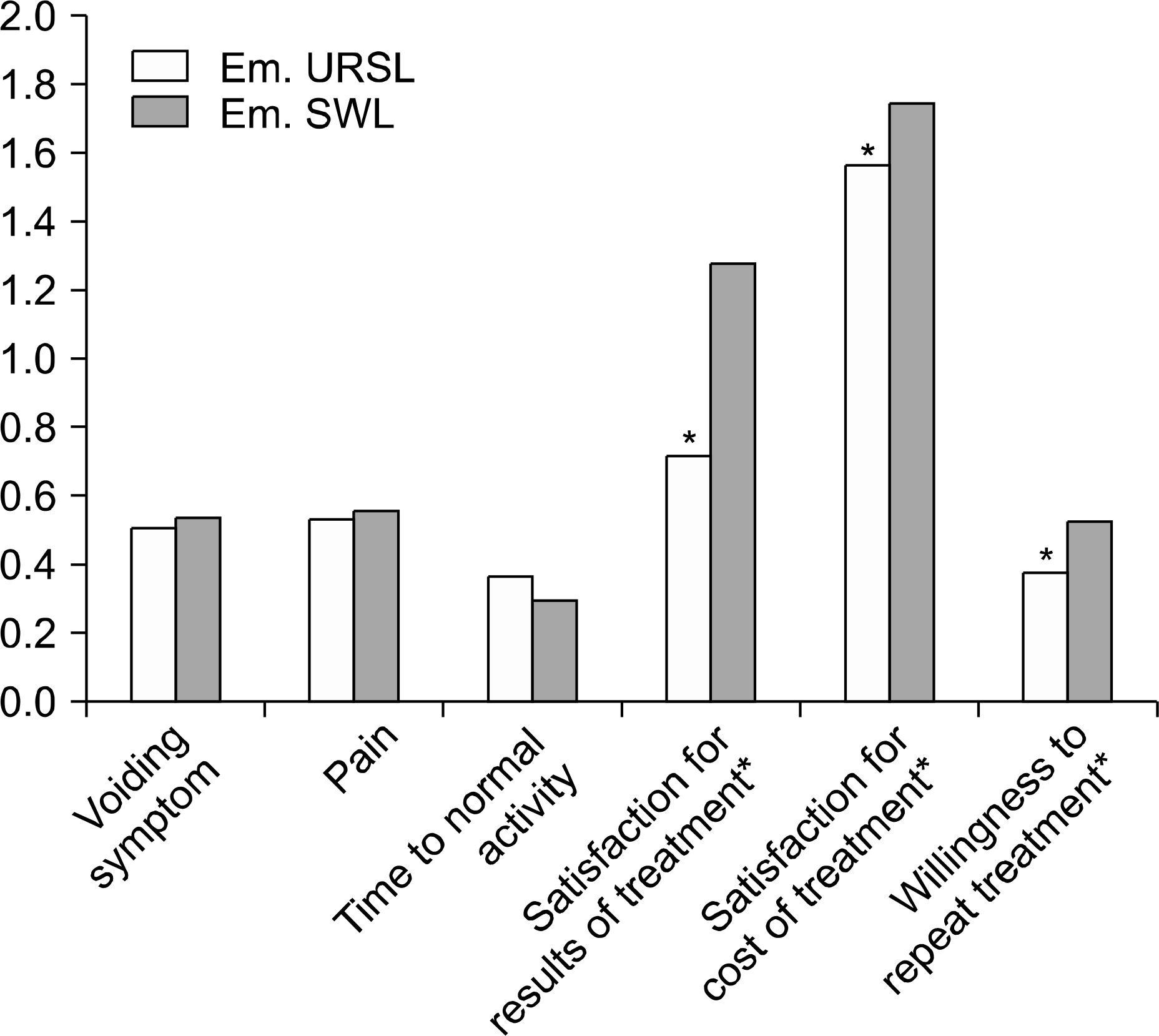Abstract
Purpose
We performed this study to determine the efficacy between the use of emergency ureterorenoscopic lithotripsy (URSL) and emergency shock wave lithotripsy (SWL) for distal ureter stones in terms of stone-free rates, complication rates and patient satisfaction.
Materials and Methods
This prospective study included 145 patients with distal ureter stones who underwent emergency URSL (URSL group, n=64) and emergency SWL (SWL group, n=81). All emergency URSL and SWL procedures were performed within eight hours of admission. Stone status was evaluated with either an intravenous pyelogram or the use of non-enhanced CT. URSL was performed with 7.5 Fr semirigid ureterorenosope and SWL was performed with Sonolith PRACTIS V.5.0(EDAP TECHNOMED). The stone-free rates, complication rates, visual analogue pain scale and patient satisfaction scores were analyzed for each group of patients.
Results
The overall stone-free rates of the URSL and SWL group of patients at two weeks were 96.8% and 74%, respectively (p=0.001). Complication rates were similar (28.1% versus 27.1%, p=0.897). The patient satisfaction score was statistically significant in favor of patients that underwent emergency URSL.
Go to : 
REFERENCES
1. Perez-Castro Ellendt E, Martinez-Pineiro JA. Transurethral ureteroscopy. A current urological procedure. Arch Esp Urol. 1980; 33:445–60.
2. Kwon YU, Lee SI, Jeong TY. Treatment of upper and mid ureter stones: comparison of semirigid ureteroscopic lithotripsy with Holmium: YAG Laser and shock wave lithotripsy. Korean J Urol. 2007; 48:171–5.

3. Chaussy C, Schmiedt E, Jocham D, Brendel W, Forssmann B, Walther V. First clinical experience with extracorporeally induced destruction of kidney stones by shock waves. J Urol. 1982; 127:417–20.

4. Segura JW, Preminger GM, Assimos DG, Dretler SP, Kahn RI, Lingeman JE, et al. Ureteral Stones Clinical Guidelines Panel summary report on the management of ureteral calculi. J Urol. 1997; 158:1915–21.

5. Singal RK, Denstedt JD. Contemporary management of ureteral stones. Urol Clin North Am. 1997; 24:59–70.

6. Pearle MS, Nadler R, Bercowsky E, Chen C, Dunn M, Figenshau RS, et al. Prospective randomized trial comparing shock wave lithotripsy and ureteroscopy for management of distal ureteral calculi. J Urol. 2001; 166:1255–60.

7. Ghalayini IF, Al-Ghazo MA, Khader YS. Extracorporeal shockwave lithotripsy versus ureteroscopy for distal ureteric calculi: efficacy and patient satisfaction. Int Braz J Urol. 2006; 32:656–64.

9. Anderson KR, Keetch DW, Albala DM, Chandhoke PS, Mc-Clennan BL, Clayman RV. Optimal therapy for the distal ureteral stone: extracorporeal shock wave lithotripsy versus ureteroscopy. J Urol. 1994; 156:62–5.

10. Osorio L, Lima E, Soares J, Autorino R, Versos R, Lhamas A, et al. Emergency ureteroscopic management of ureteral stones: why not? Urology. 2007; 69:27–31.

11. Tligui M, El Khadime MR, Tchala K, Haab F, Traxer O, Gattegno B, et al. Emergency extracorporeal shock wave lithotripsy (ESWL) for obstructing ureteral stones. Eur Urol. 2003; 43:552–5.

12. Shah OD, Matlaga BR, Assimos DG. Selecting treatment for distal ureteral calculi: shock wave lithotripsy versus ureteroscopy. Rev Urol. 2003; 5:40–4.
13. Harmon WJ, Sershon PD, Blute ML, Patterson DE, Segura JW. Ureteroscopy: current practice and longterm complications. J Urol. 1997; 157:28–32.

14. Park HK, Paick SH, Oh SJ, Kim HH. Ureteroscopic lithotripsy under local anesthesia: analysis of the effectiveness and tolerability. Korean J Urol. 2003; 44:791–5.
Go to : 
 | Fig. 1.Evaluation of patient satisfaction. ∗: p-value<0.05. Scores for treatment results, cost and willingness were significantly lower in the emergency ureterorenoscopic lithotripsy (URSL) group than in the emergency shock wave lithotripsy (SWL) group of patients. |
Table 1.
Questionnaire about patient satisfaction
Table 2.
Characteristics of the patients
Table 3.
Complications of emergency URSL and emergency SWL




 PDF
PDF ePub
ePub Citation
Citation Print
Print


 XML Download
XML Download